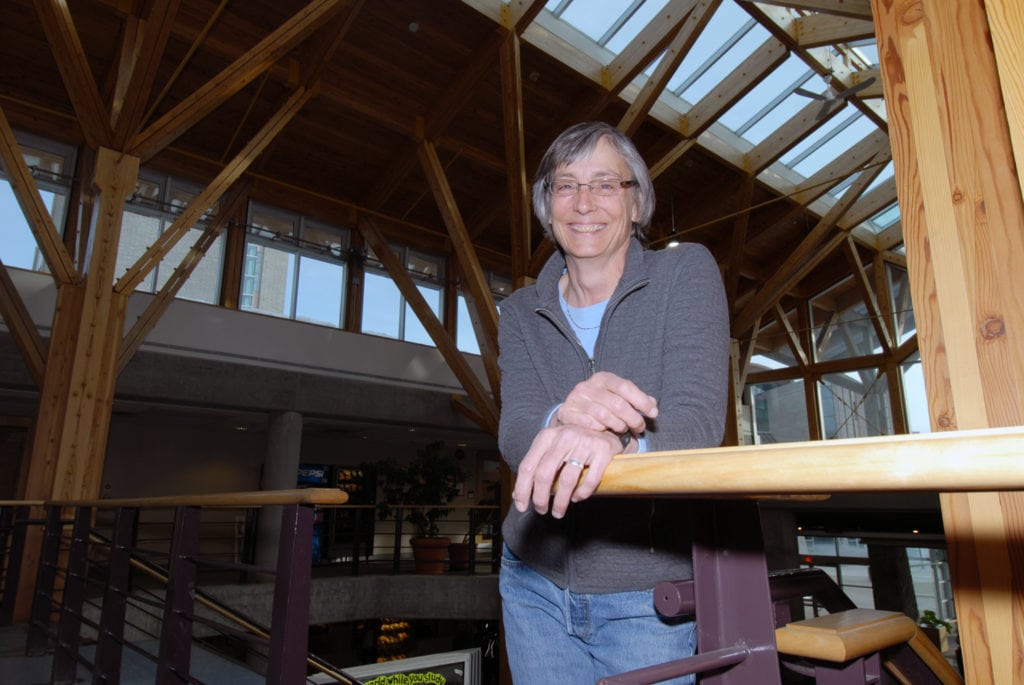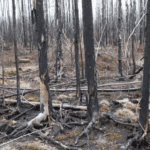Dr. Kathy Lewis never planned to become a professor in the University of Northern British Columbia’s (UNBC) Ecosystem Science and Management program. “During my PhD, I saw what junior professors went through in order to get tenure, and thought that I didn’t want to go the university route. I was more interested in working in consulting to do hands-on work in forest pathology.”

Image: UNBC
As a child, Lewis was very familiar with science, as her father was a professor in oceanography and invertebrate zoology at the University of British Columbia (UBC). Lewis thought she might want to be a vet, as she loved animals. She was also interested in conservation, though she didn’t really know what that meant. “When I was around 11 years old, I read an article about flooding the Skagit Valley and was very worried about what would happen to the animals. My parents suggested I write a letter to whatever Minister was in charge of that area; they helped me to find the contact information, but I had to write the letter. This sparked my interest in forests and conservation.”
In 1977, Lewis enrolled in UBC’s General Science program. Her father suggested she do something more focused, so Lewis decided on physical education (PE) because she liked sports and athletics, and also played varsity basketball. However, it seemed that the most likely outcome of a PE degree was being a PE teacher, which Lewis wasn’t that interested in.
During her first year, her father saw a poster on campus advertising a co-op program designed to increase the number of women in forestry and engineering. “Since I really liked the outdoors—hiking and skiing especially,” Lewis recalls, “I thought forestry would be good, plus the program got me a summer job.”
Her first summer job was with a forestry company out of Barrière, in central British Columbia (BC), where she did basic field work, including forest regeneration surveys, cut block layout, and stand-tending surveys. She enjoyed it so much that, when she returned to UBC in the fall, she switched her major to forestry. “There were only a few female students, and I don’t recall that we had any female instructors. Some of the professors made gender-biased comments, for example telling us that the mirror in the compass was not for putting on makeup. But for the most part I felt well-treated as a minority,” she says.
After finishing her BSc in Forestry in 1983, Lewis moved to Prince George, BC, for the first time in what would end up being a lengthy association with that city. She had a summer job with the federal Department of Northern and Indian Affairs (now Indigenous and Northern Affairs Canada), as an assistant to the forester, which involved assisting with road and cut block layout, planting, and tree cone-collecting activities. At the same time she was looking for master’s opportunities, having developed an interest in forest pathology during a course with Dr. Bart Van Der Kamp, and completed her undergrad thesis on the topic.
Near the end of the summer, Lewis was accepted into an MSc program in forest pathology at Virginia Tech, working with Dr. Sam Alexander. Her thesis examined the spread of a fungal root pathogen in Christmas tree plantations, which produced sticky spores that can be transported between trees by insects.
As luck would have it, just as Lewis was finishing her MSc in Virginia in 1985, the BC government was hiring a Regional Forest Pathologist. Lewis applied and ended up back in Prince George for two years, after which she decided to do a PhD to learn more about forest pathology.
“I’d met many scientists at different conferences both during my MSc and while I was working, and had found two people I was interested in studying with,” says Lewis. “One was at the University of California, Berkeley, and the other was at Oregon State University (OSU) in Botany and Plant Pathology. I chose the OSU position even though the funding my supervisor, Dr. Everett Hansen, had lined up fell through. I really wanted to work with him, so I went anyway.”
“I studied root diseases of spruce, and funded myself by writing a grant under a joint Federal-BC program called the Forest Resource Development Agreement. The grant supported a study in BC’s central interior, and I used the funding to cover a research assistantship to an OSU student (me), which meant I avoided having to pay higher out-of-state fees. Every summer I drove up to Prince George to do my field work, then returned to OSU in the fall for my lab work and classes.”
Though she worked out of Corvallis, Oregon, Lewis was becoming strongly attached to the Prince George region. “I really enjoyed the area, and connected with a number of people who hiked, canoed, and did other outdoor activities that I loved.” Upon finishing her PhD, Lewis and her (new) husband took a six month bike trip through Eastern Europe and Turkey. When they returned, Lewis joined Industrial Forestry Services Ltd., a major Prince George consulting company, and stayed with them for almost three years.
While Lewis was initially focused on the consulting path, a detour partway through her career led to her current professor position.
“As a consultant, I also taught a forest pathology course at Prince George’s College of New Caledonia, and discovered that I really enjoyed teaching. At the same time, UNBC was under construction. Given my interest in teaching, I was more receptive to joining the university than I had been during my PhD. I found that working in consulting limited what I could study because the projects were usually very narrow in scope.” She did find, however, that the experience of working in consulting gave her a good grounding in practical forestry issues.
Lewis was a hired by UNBC in 1993 as one of their first 40 faculty members, and immediately set about developing her research program. These days, she investigates the influence of biotic disturbance agents such as fungi and insects on forest ecosystems, and how their impact changes with external factors such as forest management practices and climate change. She uses tree ring analysis to understand the past influence of disturbance agents on forest dynamics, and to compare that with present conditions.
Once her research program was established, Lewis and her husband had two children. Lewis was determined to remain their primary caregiver, though she acknowledges that it came at the expense of research productivity. “I’ve made some decent research contributions, but not at the same level as many of my male colleagues, or female colleagues who don’t have children,” she says, matter-of-factly. “I’m proud of my ability to balance my work and my home life, and the fact that I also contribute significantly to our community through volunteer activities. It does get to me sometimes though, when I go to conferences and hear about all the great accomplishments, new discoveries, etc. that my colleagues are making, and I feel left in the dust.”
Lewis attributes some of this feeling of being “left in the dust” to having served as department head for the past eight years, an administrative burden that has reduced both her research and teaching roles at UNBC.
Lewis feels she’s always been somewhat blind to gender issues. “I was brought up believing that girls can climb trees, run chain saws, etc., just as much and as well as boys,” she says. While she doesn’t recall many challenges relating directly to being a woman, she notes that maternity leave and tenure issues have improved over time, but there is still pay inequity and a dearth of women who become full professors.
“When I was pregnant with my first child, we were still in the early stages of developing academic programs and administrative procedures at UNBC, and I was the Acting Chair of Forestry. Late in my pregnancy, my Dean asked me—during a meeting with other faculty—if I could delay my maternity leave,” Lewis recalls. “He meant well: he was supportive of me taking a leave and had the best interests of the institution at heart, but it demonstrated a lack of understanding of where a woman’s priorities will be when she has children—especially young children.”
Lewis’s advice to women interested in science careers? “Follow whatever you’re interested in. If you leave enough doors open by doing well in school, or getting involved as a volunteer so people get to know you, opportunities will arise that you’ll be ready to take.”




